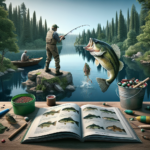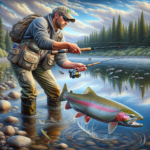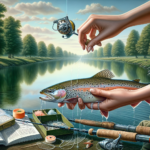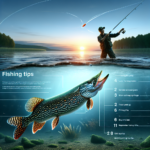Fishing Tips on How to Catch Brown Trout
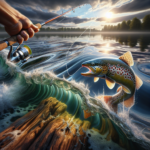
Introduction
Brown trout (Salmo trutta) are a highly sought-after species in the world of sport and recreational fishing. Known for their elusive nature and fighting spirit, they provide a thrilling challenge for anglers of all skill levels. This article aims to provide comprehensive tips and techniques for catching brown trout, covering everything from their physical characteristics and habitats to the best fishing techniques and gear recommendations.
Fish Species Overview
Description
Brown trout are easily recognizable by their golden-brown color, adorned with black and red spots along their flanks. They typically range in size from 12 to 20 inches, although larger specimens can reach up to 30 inches or more. Their streamlined bodies and powerful tails make them formidable fighters when hooked.
Habitat
Brown trout are versatile and can be found in a variety of freshwater environments, including rivers, streams, lakes, and reservoirs. They prefer cool, well-oxygenated waters with plenty of cover, such as submerged rocks, logs, and overhanging vegetation. Common regions where brown trout are found include North America, Europe, and parts of Asia.
Behavior
Brown trout are opportunistic feeders, preying on a wide range of aquatic and terrestrial insects, small fish, and crustaceans. They are most active during dawn and dusk, making these times ideal for fishing. Spawning typically occurs in the fall, when they migrate to shallow, gravelly areas to lay their eggs.
Challenges
Anglers often face several challenges when targeting brown trout. These fish are known for their wariness and can be easily spooked by noise or sudden movements. Additionally, their preference for hiding in cover makes them difficult to locate and catch.
Best Time to Catch Brown Trout
Seasonal Considerations
The best time to catch brown trout varies depending on the region, but generally, spring and fall are considered prime seasons. During these times, water temperatures are cooler, and the fish are more active and willing to feed.
Time of Day
Brown trout are crepuscular, meaning they are most active during the early morning and late evening. Fishing during these times increases your chances of success, as the fish are more likely to be feeding.
Weather Conditions
Ideal weather conditions for brown trout fishing include overcast skies and calm waters. Cloudy days reduce light penetration, making the fish less cautious and more likely to bite. Additionally, stable weather patterns are preferable, as sudden changes can disrupt feeding behavior.
Top Fishing Techniques for Brown Trout
Fly Fishing
Fly fishing is a popular and effective technique for catching brown trout. Using artificial flies that mimic the fish’s natural prey, anglers can entice strikes by presenting the fly in a lifelike manner. This technique requires skill and practice but can be highly rewarding.
Spin Fishing
Spin fishing involves using a spinning rod and reel with various lures, such as spinners, spoons, and soft plastics. This technique is versatile and can be used in a variety of water conditions. The key is to match the lure size and color to the local forage.
Bait Fishing
Bait fishing with live or natural baits, such as worms, minnows, or insects, can be highly effective for brown trout. This method is particularly useful in slower-moving waters where the fish have more time to inspect the bait.
Pro Tips
- Use stealth when approaching fishing spots to avoid spooking the fish.
- Match the hatch by using flies or lures that resemble the local insect population.
- Vary your retrieval speed and pattern to trigger strikes from hesitant fish.
Recommended Gear for Catching Brown Trout
Fishing Rod and Reel
A medium-light to medium-action spinning or fly rod is ideal for brown trout fishing. For spinning setups, a reel with a smooth drag system and a capacity of 100-150 yards of line is recommended. For fly fishing, a 4-6 weight rod with a matching reel is suitable.
Fishing Line
For spinning setups, a 6-10 lb test monofilament or fluorocarbon line is recommended. Fly anglers should use a weight-forward floating line for most situations, with a 9-foot tapered leader.
Hooks and Baits
When bait fishing, use size 8-12 hooks for worms and insects, and size 4-6 hooks for minnows. Effective artificial baits include spinners, spoons, and soft plastics in natural colors.
Additional Gear
- Polarized sunglasses to reduce glare and spot fish more easily.
- Waders for accessing deeper water and staying dry.
- A landing net to safely handle and release fish.
Best Locations to Find Brown Trout
General Locations
Brown trout can be found in a variety of freshwater environments, including rivers, streams, lakes, and reservoirs. They prefer areas with cool, well-oxygenated water and plenty of cover.
Specific Regions
Popular regions for brown trout fishing include the Rocky Mountains, the Great Lakes, and the rivers of the northeastern United States. In Europe, the rivers and lakes of Scotland, Ireland, and Scandinavia are renowned for their brown trout populations.
Common Mistakes to Avoid
Using the Wrong Gear
Using gear that is too heavy or too light can reduce your chances of success. Ensure your rod, reel, and line are appropriately matched for brown trout fishing.
Ignoring Local Knowledge
Local anglers often have valuable insights into the best fishing spots and techniques. Don’t hesitate to ask for advice or consult local fishing reports.
Being Impatient
Patience is key when fishing for brown trout. Take your time to thoroughly fish each spot and be prepared to move if you’re not getting bites.
Catch and Release Tips
Importance of Conservation
Practicing catch and release helps ensure healthy fish populations for future generations. Always handle fish with care and release them promptly.
Proper Handling Techniques
- Use wet hands or a wet cloth to handle fish, reducing the risk of removing their protective slime coat.
- Avoid touching the gills or eyes.
- Use barbless hooks to make release easier and less stressful for the fish.
Legal Considerations
Be aware of local regulations regarding size limits, bag limits, and protected areas. Always follow these rules to support sustainable fishing practices.
Frequently Asked Questions (FAQs)
What is the best bait for catching brown trout?
The best bait for brown trout varies depending on the season and local conditions. Common natural baits include worms, minnows, and insects. Effective artificial baits include spinners, spoons, and soft plastics that mimic the local forage.
Where is the best place to fish for brown trout?
Brown trout are commonly found in cool, well-oxygenated freshwater environments such as rivers, streams, lakes, and reservoirs. Popular fishing spots include the Rocky Mountains, the Great Lakes, and the rivers of the northeastern United States.
What time of day is best for catching brown trout?
Brown trout are most active during the early morning and late evening. Fishing during these times increases your chances of success, as the fish are more likely to be feeding.
What type of fishing line should I use for brown trout?
For spinning setups, a 6-10 lb test monofilament or fluorocarbon line is recommended. Fly anglers should use a weight-forward floating line with a 9-foot tapered leader.
Do I need a special fishing license to catch brown trout?
Fishing license requirements vary by region. Check with local authorities to determine if a special license or permit is needed for brown trout fishing. Be aware of size limits, bag limits, and any protected areas.
What is the best technique for catching brown trout?
Effective techniques for catching brown trout include fly fishing, spin fishing, and bait fishing. Fly fishing is particularly popular, using artificial flies that mimic the fish’s natural prey. Spin fishing with lures such as spinners and spoons is also effective.
Are there any specific weather conditions that improve the chances of catching brown trout?
Ideal weather conditions for brown trout fishing include overcast skies and calm waters. Cloudy days reduce light penetration, making the fish less cautious and more likely to bite. Stable weather patterns are preferable, as sudden changes can disrupt feeding behavior.
Can I catch brown trout from the shore, or do I need a boat?
Brown trout can be effectively caught from both shore and boat. Shore fishing is often productive in rivers and streams, while a boat can provide access to deeper water in lakes and reservoirs. Use stealth when approaching fishing spots to avoid spooking the fish.
How can I improve my chances of landing a big brown trout?
To catch larger brown trout, focus on using larger baits or lures that mimic the fish’s natural prey. Fish during prime feeding times (early morning and late evening) and target areas with plenty of cover, such as submerged rocks and logs.
What should I do if I plan to release brown trout after catching them?
When practicing catch and release, handle the fish with care to ensure their survival. Use wet hands or a wet cloth to handle the fish, avoid touching the gills or eyes, and use barbless hooks to make release easier. Release the fish promptly and gently back into the water.
Conclusion
Brown trout fishing offers a rewarding challenge for anglers of all skill levels. By understanding their behavior, habitat, and feeding patterns, and using the right techniques and gear, you can increase your chances of success. Remember to practice ethical fishing practices and conservation to ensure healthy fish populations for future generations. Now, armed with these tips, it’s time to hit the water and experience the thrill of catching brown trout.

